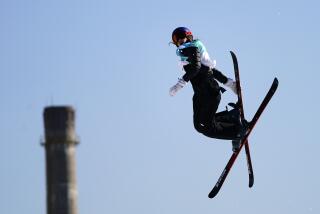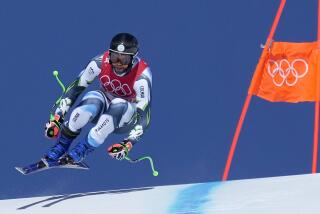BREAKTHROUGH : Skiing Takes a Turn for the Better With Super-Sidecut Skis
In a move so simple it’s a wonder nobody thought of it before, ski manufacturers have come up with a technological breakthrough that could yank the sport off the stagnant plateau along which it has plodded for the last decade or so.
With the new skis, also called “parabolic” and “super-sidecut,” first-day beginners are coming back for seconds and longtime intermediates are suddenly carving parallel turns. Even experts are joining the fun.
Of course, such a revolution has been touted before: Clif Taylor’s shorty skis and the graduated-length method were supposed to put everyone on black-diamond runs back in the 1970s.
But this latest development appears to rank up there with release bindings and custom-fit boots, not to mention detachable-quad chairlifts and sexy, high-fashion ski outfits.
The hype, it seems, is true.
*
Shaped skis are different from traditional skis in that they are narrower in the middle--sidecut, in other words--and wider at the tips and tails. This makes it easier to set the edges for turning smoothly, and the increased width at both ends means the skis can be shorter and less cumbersome without losing stability.
“The more radical the sidecut, the easier it is to turn,” Mary Jo Tarallo, spokeswoman for Snow Industries America (SIA), said from her office in Baltimore. “The Elan SCX is the most radical, the Head Cyber middle of the road. Advanced skiers need something like the K2 Four.”
Kneissl made the first shaped ski back in 1992, and its Ergo, for powder, is still around. However, Elan popularized the concept and persuaded many ski schools to go along.
“By last winter,” Tarallo said, “there were eight models on the market. Now, there are more than 60, and judging from both our sales figures and anecdotal evidence, they’re jumping off the racks.
“In the five months from last August through December, 60% of the skis sold were shaped, and the trend is continuing.
“Also, next season, there will be boots designed especially for sidecut skis. They’ll be stiff laterally but have more forward flex to help put pressure on the tips while making a turn.”
Although turning is easier, improper technique still poses the threat of injury, especially to the knees.
“There have been rumors about numerous people being hurt while on shaped skis,” Tarallo said. “But research by both the National Ski Patrol and the Professional Ski Instructors Assn. has turned up no empirical evidence that skiers are any more likely to be injured on them than on traditional skis.”
*
So, where can a skier take a test-drive on these road-huggers?
Just about anywhere.
Most shops have them in stock, and Mammoth Mountain, for one, has made shaped skis its standard rentals, providing the Rossignol Cut 10.4 in five sizes at the regular rate, as well as other models at a premium.
“Our ski school specializes in teaching shaped-ski technique,” said Pam Murphy, Mammoth’s director of marketing. “And these skis aren’t only for beginners and intermediates who want to improve, but for experts too. My boyfriend is a very advanced skier who used to scoff at sidecuts. But I talked him into trying them, and now he’s going to buy a pair.”
In the Southland, Bear Mountain, Snow Summit, Snow Valley and Mountain High all have shaped skis available in their demonstration, rental and ski-school programs.
Snow Summit has so much confidence in super-sidecuts that its GuaranSki program guarantees a beginning skier, accompanied by an instructor, will be able to ski from the top of the mountain after four hours of lessons. The cost, for lift ticket, four hours of instruction, boots, poles and Rossignol Cut 10.4 skis, is $49 midweek, $59 on weekends and holidays.
If a skier is not prepared to ski from the top after four hours, he or she will receive a voucher for a free two-hour lesson until he or she can.
Bob Roberts, executive director of California Ski Industry, said shaped skis are the wave of the future, if not the present.
“Most resorts in the state are in the process of converting their rentals to super-sidecuts,” he said from San Francisco. “The larger ones are moving more quickly, but it’s definitely the direction everyone is headed.”
In the Sierra, all six Ski Lake Tahoe resorts--Alpine Meadows, Heavenly, Kirkwood, Northstar-at-Tahoe, Sierra-at-Tahoe and Squaw Valley USA--offer traditional and shaped skis at varying rates. An all-day rental at Heavenly, to cite a typical example, is $20 for traditional skis, $30 for sidecuts.
Which leads naturally to the question: How much do these shaped skis cost at retail?
Prices range from about $300 to $500 a pair, with the K2 Fours running possibly as high as $600. Comparable traditional skis range from about $280 to $400.
“A lot of technology went into developing super-sidecut skis,” the SIA’s Tarallo said. “And companies have to get those costs back. But prices will probably go down eventually, and as with any product, supply and demand is involved.”
*
So far, Alpine racers have not flocked to shaped skis, preferring to remain on models designed for their specialties--slalom, giant slalom, super-G or downhill.
“We’ve heard of a few competitors who have tried super-sidecuts in races,” U.S. Skiing spokeswoman Deborah Engen said from Park City, Utah, “but they were mainly juniors or those on levels below the World Cup.”
The idea, of course, in a downhill is to go fast and relatively straight. And in the more technical events, ease of turning is not as important as maintaining the most efficient line down the course while carrying speed through the gates.
However, some of the same technology has come into play with racing skis, which take many forms for varying terrain, snow conditions, race courses and racers’ individual techniques.
*
Assuming shaped skis continue to keep new skiers skiing, at least one industry official isn’t so sure it will be enough to get another 1960s-like boom going.
David Ingemie, president of SIA based in McLean, Va., agreed that the new skis have provided an “incredible” boost, comparing them to the original Prince tennis racket and Callaway oversized golf clubs, but he added:
“Sure, they will enable skiers to stay on the slopes longer, and it’s more likely that beginners will make the three visits we consider necessary before they become committed to the sport. But other factors are working against us.
“Many small ski areas have gone out of business, and the major resorts are somewhat remote from most population centers. Also, vacation days are declining and a lot of people have become too busy to go skiing.”
SIA estimates there are between 9.5 million and 11.5 million skiers in the United States--not counting about 2.5 million snowboarders. But apparently, too many skiers are working too hard to have any fun.
(BEGIN TEXT OF INFOBOX / INFOGRAPHIC)
The Advantage
Sidecut skis have a shorter turning radius than conventional skis.

